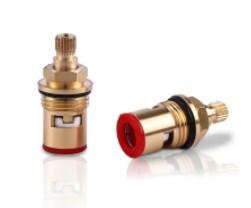When comparing the Ceramic Valve Core to a traditional rubber valve core, several clear advantages become evident, especially in terms of durability, precision, and performance over time. One of the most significant benefits of the Ceramic Valve Core is its exceptional wear resistance. Ceramic materials, typically alumina or zirconia-based, are incredibly hard and can maintain their structural integrity even after hundreds of thousands of operational cycles. In contrast, rubber components are inherently softer and more prone to deformation or breakdown under constant pressure and temperature fluctuations, leading to reduced sealing efficiency and a shorter product life.
Another critical advantage of the Ceramic Valve Core is its resistance to heat and corrosion. Ceramic does not react with water or most chemicals and remains stable even in high-temperature environments. This makes it ideal for use in faucets, shower valves, and other plumbing fixtures that deal with hot and cold water daily. Rubber valve cores, on the other hand, tend to degrade when exposed to elevated temperatures or harsh water conditions over time, especially if the water contains high levels of chlorine, minerals, or other corrosive agents. This degradation often leads to leakage or sticky operation, which can compromise the functionality of the entire fixture.
Precision control is another area where the Ceramic Valve Core excels. Because ceramic discs slide over each other with minimal friction and extremely tight tolerances, they allow for smooth and accurate adjustment of water flow and temperature. Users typically experience a more fluid and responsive feel when operating fixtures equipped with ceramic technology. Rubber valve cores, in comparison, tend to provide less precise control due to their elastic nature and susceptibility to pressure distortion. As a result, they may not offer the same level of user comfort or consistency, particularly after prolonged use.
Furthermore, the low maintenance nature of the Ceramic Valve Core makes it more attractive for both manufacturers and end-users. Its smooth surfaces are less prone to collecting debris or mineral buildup, and it does not require lubrication to operate effectively. This translates to a reduced need for repair or replacement, saving time and cost in the long run. Rubber valve cores often require periodic inspection and cleaning, and they may need to be replaced more frequently, especially in areas with hard water or fluctuating pressure.
Another notable factor is reliability in long-term sealing. The hard, polished ceramic discs used in a Ceramic Valve Core form a tight, water-resistant seal when closed, and they maintain this seal even after years of usage. Rubber components, although initially flexible and sealing well, tend to harden or crack as they age, especially under continuous mechanical stress. This compromises their ability to prevent leaks, which is a common cause of faucet malfunction in older plumbing systems.
In conclusion, the Ceramic Valve Core stands out as a more advanced and durable solution compared to rubber valve cores. It offers superior resistance to wear, heat, and corrosion, as well as improved control, precision, and reduced maintenance needs. These advantages make it the preferred choice in modern plumbing applications where reliability, performance, and longevity are essential. While rubber valve cores may still be used in low-cost or temporary setups, the Ceramic Valve Core provides long-term value and a better user experience in both residential and commercial settings.
